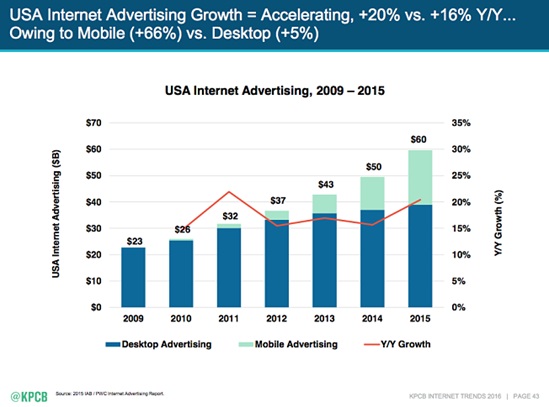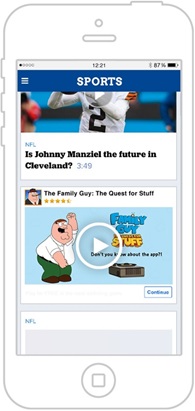The mobile advertising opportunity for brands is phenomenal, but brands are still under-spending on the format. Mark Rosner, Chief Revenue Officer at AppLovin, offers a guide to help marketers make sense of the hottest mobile ad formats today.
The mobile ad industry has come a long way since millions of primitive, low-res, untargeted banner ads first started being served across mobile screens. Those simple, crude, ineffective ads, which produced mostly accidental clicks, paved the way for the multitude of sophisticated mobile ad formats that present themselves to marketers today. Old-form online media buying has been superseded by sophisticated, data-driven buying designed to milk every last drop of ROI out of mobile ads.
The mobile advertising opportunity for brands is phenomenal – last year alone online ad revenues generated a staggering $60 billion, a whole 20 percent increase on 2014. Mobile ad revenue grew by more than 66 percent whilst desktop advertising increased by only five percent. Despite this booming opportunity, research clearly shows that brands are critically under-spending on mobile relative to how much time users are spending on mobile devices like smartphones and tablets.

To help marketers make sense of our brave, new, mobile ad-driven world, we’ve pulled together what we know are the hottest mobile ad formats today.
Mobile video ads
Video ads are an ideal platform for increasing brand awareness, supporting lead generation and increasing engagement. This format shows no sign of abating: In the US alone digital video ad spending is forecast to reach $28.08 billion in 2020, up from an already impressive $9.90 billion in 2016.
Digital video ads empower advertisers to build stronger connections along the route to purchasing on mobile, with highly targeted content across many digital channels and different devices like smartphones and tablets. Video ads tend to offer better lifetime values than competing formats because they qualify users before they reach the advertiser and deliver rich, visual experiences. Video ads are good vehicles for many types of brands including upcoming movies, food, music, retail products and, of course, games.
To succeed, brands need to have a clear understanding of their audience profiles and align video content with user interests. To increase retention and ROI, all video ad content should be actionable with clear value and calls to action displayed early on in the ads.
Playable mobile ads
This inventive format is an advert that is a game that people can actually play. Increasingly considered as a new and effective route to mobile app discovery via gaming demos, playable ads provide a great way for consumers to sample content before installing an app. You can really engage audiences like casual gamers (or anyone else for that matter) with playable content. These ads blur the boundary between apps and ads, offering rich experiences where consumers can spend more valuable minutes interacting with ads.
Whilst being fun in the moment, playable ads also deliver key benefits for marketers. Firstly, playable ads typically deliver better conversion rates – because they’re interactive they convert much faster than normal ads.
Playable ads also offer better lifetime values. They cleverly qualify consumers before they reach the advertiser as they offer deeper experiences; these users engage at an increased rate than those received from other ad channels like native and display.
Graphical interstitial mobile ads
These are full screen ads which stay on a screen for a few seconds until users are given the option to close the ad, usually by clicking on an ‘x’ in the corner. They are great for increasing brand awareness and making use of the whole mobile screen real-estate instead of just a small portion of screen. With proper placement, the interruptive nature of interstitials can be held to a minimum.
In an age of diminishing attention spans, interstitials are a potent way to grab the complete attention of users, thereby increasing engagement, click-through and conversions. They also don’t take as much time and engagement as video or playable ads and for certain areas in an app, a faster ad experience can be better. There are downsides though: As interstitials often force users to stare at them until they’re allowed to click out, lots of users find this quite irritating if shown at an inopportune time. Great care should be taken to display interstitials only in a proper context like between levels on a game, at natural breaks in the app, or at the end of a session or specific app function.
Native mobile ads
Native advertising is paid content which matches the app’s “native” format, hence delivering a less interruptive experience for users. Native ads have the same design elements, copy layout, UI and buttons as the app. Mobile marketers need the following six ingredients to deliver native mobile ads: URL, thumbnail, headline, description, brand logo and brand name.
By delivering ads that appear to be in the same format as the publisher or outlet, they’ve proven to be effective at generating higher click rates than traditional mobile ads.
Native ads are extremely popular with brands: Chiefly because click-through rates are often much higher when compared to traditional ads, plus engagement is much greater. However, there is a danger that some consumers could feel native mobile ads are misleading, damaging both the reputation of the publisher and the brand. To avoid this, publishers should always conform with MMA guidelines for native ads.

Conclusion
For mobile marketers to succeed it is vitally important they understand their user tastes and preferences and create marketing strategies around them.
There isn’t just one ‘best’ mobile ad format for all – the choice of format deployed depends on a number of variable factors such as the game or app in question, the context, where the ad is placed and the frequency of placements.
With the proliferation of mobile devices, with smartphones in particular being the preferred device for consumers, it is essential that organisations deploy the right ad format strategy to leverage mobile platforms to help further drive revenues.
By Mark Rosner
Chief Revenue Officer
AppLovin

